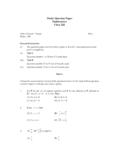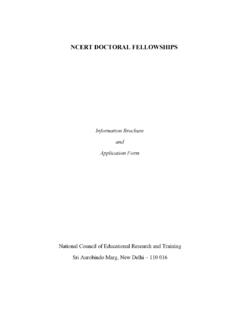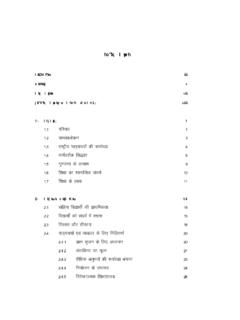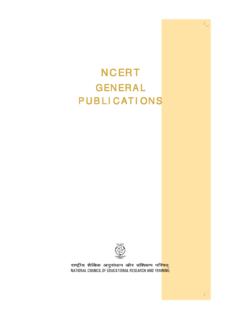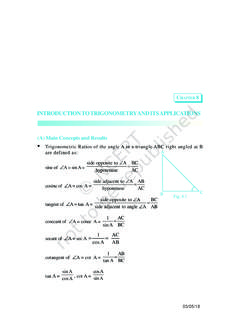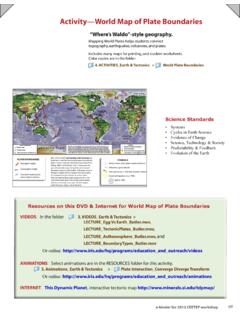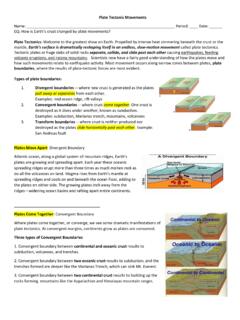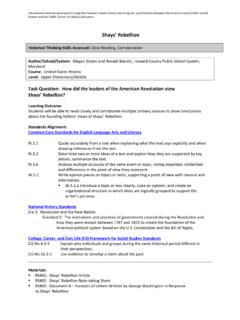Transcription of PHYSICAL FEATURES OF INDIA - NCERT
1 PHYSICAL F EATURES OF INDIA . 2. d Y. ou have already learnt earlier that INDIA The movement of the plates results in the he is a vast country with varied landforms. building up of stresses within the plates and the What kind of terrain do you live in? If continental rocks above, leading to folding, you live in the plains you are familiar with the faulting and volcanic activity. Broadly, these vast stretches of plain land. In contrast, if you plate movements are classified into three is live in hilly region, the rugged terrain with types(Figure ).
2 While some plates come towards mountains and valleys are common FEATURES . each other and form convergent boundary. Some In fact, our country has practically all major plates move away from each other and form bl PHYSICAL FEATURES of the earth mountains, divergent boundary. In the event of two plates plains, deserts, plateaus and islands. You coming together they may either collide and must be wondering how these PHYSICAL crumble, or one may slide under the other. At FEATURES have been formed. We will learn more pu times, they may also move horizontally past about major PHYSICAL FEATURES of INDIA and how they have been formed.
3 Be T. We find different types of rocks; some are very hard like marble which has been used for re making the Taj Mahal, and some are very soft o R. like soap stone which is used in making talcum powder. The colour of soil varies from one place to the other because soil is formed out of tt E. different types of rocks. Have you ever thought PLATE PLATE. about the causes of these variations? Most of Mantle Convergent Boundary these variations are caused due to differences C. in rock formations. INDIA is a large landmass formed during different geological periods which has influenced no N.
4 Her relief. Besides geological formations, a number of processes such as weathering, erosion and deposition have created and PLATE PLATE. modified the relief to its present form.. Mantle Earth scientists have attempted to explain Divergent Boundary the formation of PHYSICAL FEATURES with the help of some theories based on certain evidences. PLATE. One such plausible theory is the Theory of Plate Mantle PLATE. Mantle Tectonics . According to this theory, the crust Transform Boundary (upper part) of the earth has been formed out of seven major and some minor plates.
5 (Figure ) Figure : Plate Boundaries d he is bl Figure : World : Plate Margins pu each other and form transform boundary. The Gondwana land: It is the southern part of the movement of these plates have changed the ancient super continent Pangea with Angara Land position and size of the continents over millions in the northern part. be T. of years. Such movements have also influenced The Himalayan uplift out of the Tethys sea re the evolution of the present landform FEATURES and subsidence of the northern flank of the o R. of INDIA . peninsular plateau resulted in the formation of a large basin.
6 In due course of time this Most volcanoes and depression, gradually got filled with deposition tt E. earthquakes in the world are located at plate of sediments by the rivers flowing from the margins, but some do occur within the plates. mountains in the north and the peninsular C. plateau in the south. A flat land of extensive The oldest landmass, (the Peninsula part), was alluvial deposits led to the formation of the a part of the Gondwana land. The Gondwana northern plains of INDIA . land included INDIA , Australia, South Africa, no N. The land of INDIA displays great PHYSICAL South America and Antarctica as one single land variation.
7 Geologically, the Peninsular Plateau mass. The convectional currents split the crust constitutes one of the ancient landmasses on into a number of pieces, thus leading to the drifting the earth's surface. It was supposed to be one of the Indo-Australian plate after being separated . of the most stable land blocks. The Himalayas from the Gondwana land, towards north. The and the Northern Plains are the most recent northward drift resulted in the collision of the plate landforms. From the view point of geology, with the much larger Eurasian Plate.
8 Due to this Himalayan mountains form an unstable zone. collision, the sedimentary rocks which were The whole mountain system of Himalaya accumulated in the geosyncline known as the represents a very youthful topography with Tethys were folded to form the mountain system high peaks, deep valleys and fast flowing rivers. of western Asia and Himalaya. The northern plains are formed of alluvial 8 CONTEMPORARY INDIA . deposits. The peninsular plateau is composed northern borders of INDIA . These mountain of igneous and metamorphic rocks with gently ranges run in a west-east direction from the rising hills and wide valleys.
9 Indus to the Brahmaputra. The Himalayas represent the loftiest and one of the most MAJOR PHYSIOGRAPHIC D IVISIONS rugged mountain barriers of the world. They form an arc, which covers a distance of about The PHYSICAL FEATURES of INDIA can be grouped 2,400 Km. Their width varies from 400 Km under the following physiographic divisions in Kashmir to 150 Km in Arunachal Pradesh. (Figure ): The altitudinal variations are greater in the (1) The Himalayan Mountains eastern half than those in the western half. (2) The Northern Plains The Himalaya consists of three parallel d (3) The Peninsular Plateau ranges in its longitudinal extent.
10 A number (4) The Indian Desert of valleys lie between these ranges. The (5) The Coastal Plains he northern most range is known as the Great (6) The Islands or Inner Himalayas or the Himadri'. It is the most continuous range consisting of the The Himalayan Mountains loftiest peaks with an average height of 6,000. The Himalayas, geologically young and metres. It contains all the prominent is structurally fold mountains stretch over the Himalayan peaks. bl pu be T. re o R. tt E. C. no N.. Figure : Himalayas PHYSICAL FEATURES OF INDIA 9. d he is bl pu be T.

